San Diego Newspaper Archives 1800s-Early 1900s: African American Music History
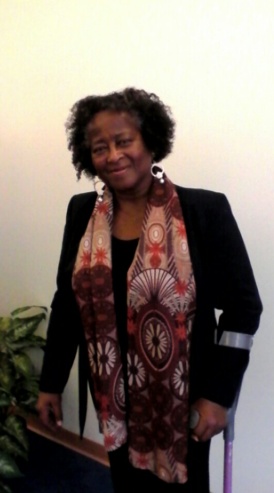
Delores Fisher Historic African American Music Researcher
Update 2016– More interesting newspaper articles, archival snippets, images and videos!
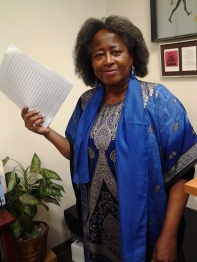
Delores Fisher music researcher
Update 2014 Although many libraries and academic institutions have increased their postings of digitalized newspaper archives, it is still fun and exciting for me to handle the original aged paper document. Whether it’s sometimes eerily thick and firm, sometimes thin and crumbling, sometimes faded, yellowed, a majority exist in cool sealed, artificial “plastic” shells. When documents are not available, I like to look at faded old fashioned flimsy microfilm or microfiche. The new San Diego Central Library has all three.
New San Diego Central Library
San Diego’ Central Library is finally completely rebuilt and houses an expanded traditional Special Collections archive room, a newspaper/magazine area, and microfiche/microfilm genealogy computer stations. The latest technology enhancements to the traditional archival storage methods, allows blended methodology researchers like me to access old school technology and new school computerized technology either on site or with “distance” Internet interaction. A researcher can scan and print, or save documents to USB, or send scanned images to email. The Central Library’s new system is accessible not just to scholars and researchers, but to all patrons.
New San Diego Central Library
I want to give a shout out: Thank you newspaper room staff for the updated list of historic San Diego News papers. It saves time with listings of when a newspaper merged or became defunct. My previous “guestimates” and challenges to topic verification in multiple sources, wasted valuable research hours.
To Rick Crawford—thank you so much for your advice about cross referencing newspaper articles. It continues to yield valuable perspectives as I engage in my inquiry into San Diego’s colorful past!
NEWSPAPER ARCHIVES
This page reflects an area of research that has been very exciting and hopefully will continue to provide future hours of enjoyment. It emerged from the guiding mentorship in textual archives research techniques during an undergraduate semester with now deceased Dr. Laurel Amtower. She continued mentoring and encouraging my archival endeavors through and beyond masters years at San Diego State. Her death left an unfilled void. http://www-rohan.sdsu.edu/~amtower/moi.html
Throughout my graduate years at SDSU, Dr. Lewis Peterman http://music.sdsu.edu/newsite/index.php/faculty_bios/peterman , now professor Emeritus, assured me to follow my heart, that historical music studies were worth the pursuit. While a host of friends kept scratching their heads asking,”Why??” His longitudinally research oriented mentorship allowed me to consider a future in research as viable, not just a hobby to pursue in spare time idle moments.
My eyes today, several years later, light up in response to those with frowning faces and puzzled head scratches. “Why.” . . . “Why Not?”
I am also grateful for extended study and workshop opportunities to reach youth with the message that our past is not boring and irrelevant. I also provide workshops ( Center for World Music http://centerforworldmusic.org/artist-teachers/ In class experience enhances appreciation of applied African American music history.
After earning the MA in Music(Musicology), I had a very expansive and informative stint as a research assistant and African American music history researcher with the La Jolla Athenaeum Music and Arts Library (Director Erika Torres) under the guidance of Music Director Judith Oishei. The Library’s knowledgeable staff and extensive resources filled my days with reading, researching, writing, listening, examining 19th century American Popular sheet music, and attending concerts that I would probably not have been able to fully enjoy elsewhere.
Next, I am indebted to Karen Huff-Willis for rescuing me during a time of self doubt and flagging focus.
http://sohosandiego.org/board/boardhuff.htm She provided additional hands on training with newspaper and magazine sources, not only cataloging and basic restoration techniques, but also the practical discipline needed to tissue out nuggets of information hidden in articles and advertisements–that is the ground for this page.
I am also indebted to the entire faculty and staff of the Africana Studies Department at San Diego State University. We are now enjoying more than forty years of academic and community scholarship http://www-rohan.sdsu.edu/~afras/undergraduate.htm
And last but not least, of academic colleagues and mentors, Michael Lapin of the SDSU media Center continues to provide insights and to share his knowledge of San Diego history that few have acquired. Any cause for criticism is due to my error and not to the educational foundation and guidance obtained from the above mentors who have contributed so richly to my life.
Ultimately however, I send a silent and deeply felt thank you to my mother. One day when I was a teenager, restless as most teens are during the summer and “bored,” I went upstairs to our attic which my dad had converted into two bedroom areas. On the right-hand side by the stairs, in back of a large beam were barrels and an old traveler’s chest. I rambled through the memories I found in them and came across some newspaper clippings about a heavy weight boxer named Joe Lewis.I didn’t know who he was and wondered why such fuss was made over him(evident by the photo of a Black man on the front page of a newspaper).
I kept searching, founding other articles, but the Joe Lewis ones were from the 1930s and had photos. “Who had saved them and why? I wondered. When I took them to my mom, she held them gently, smiled a strange distant smile, and almost cried. She said, “I forgot I had these.” Then quietly, she told me about Joe Lewis the boxer and his importance to African Americans at that time. I had never heard of Joe Lewis. We spent many hours together talking about lived history, the history not just in print, but in her experiences of various events. So fascinating!
My mom and I folded the clippings back and placed them in a box downstairs where she could re-read them whenever she wanted. I think that was the first time I started to feel drawn to historical memories.
That’s what archives are for me– lived memories of elders, preserving an image, an story, a fragrance of eras past for future generations. Our cassettes, CDs, DVDs, films, digital photos, magazines, newspapers and perhaps even our tweets and texts will become archives soon enough. . . .
This page has been a few summers coming, but the newspapers of San Diego are yielding very interesting information about our cultural and music scene as we developed into a major California city.
Delores Fisher
A FEW THOUGHTS ON HOW TO GET STARTED-CONDUCTING MUSIC HISTORY ARCHIVAL RESEARCH
It isn’t always easy to access primary sources. It takes time. Here’s a few hints:
Make and keep a well organized list of topics and events when you first encounter them in a source(book, TV show, conversations with older people. Some documents have probably been hiding right in your own home, stored away in boxes or envelopes in family storage spaces.
Libraries have Special Collection archives often donated by people like you and me. Diaries, journals, turn of the 20th century sheet music, vinyl records, and yes . . .newspapers. Firsthand sources or accounts of events can be uncovered by a diligent researcher.
Are you looking for historic information about the 1800s? Most papers from that era, if not properly preserved will have crumbled by now. So . . . search among library boxes of pre-1900 Newspaper Microfiche and Microfilm. Many of these treasure troves have not been, and probably won’t be digitalized.
Read as much as you can about your topic. Go beyond Internet sites (follow the suggested books and articles listed in end notes or footnotes.) It takes knowledge of one’s topic and patience.
Following this post, I have inserted a visual research map conception that might be helpful to those of you who enjoy primary source material, especially the challenges and joys of Newspaper Archive hunting.
Think about possible primary resource documents as “Texts” in a variety of formats. Describe the newspaper format. Does it change? When? Why? Has it merged with any other newspapers? Once, there was a San Diego Union, A Daily Bee, and A San Diego Tribune. We new read it daily as the San Diego Union-Tribune. Newspapers were written from that era’s perspective usually by journalist who actually saw, heard, or experienced an event. They were there.
An added note of caution: for purposes of critical commentary, annotation, or literature reviews in your essays/papers, remember to do a research search for the credibility, or reliability of your primary source(s). What do others say about the newspaper’s ethics?
Were their writers known to have a bias. Did they regularly overlook or include certain participants? Are his/her narratives considered factual unfoldings of events without distracting exaggeration? Does the writer “shape” the account into literary conventions of the day?
Also consider . . . . do other existing “rival” narratives conflict with your source? Specific Newspapers–no matter what the era– have been observed to slant story line facts toward their editorial ideology–if so, how and for what probable reason(s)?
Keep a notebook nearby to reflect on what you are experiencing as you do your research. Usually, permission must be given to video yourself as you do research in special collections sections or take photos of staff. So cell phones or tablets may not be helpful. Just know that for many archival researchers . . . something happens when we have to physically handle a historic object, analyze its content or texture, write about an entry or sketch an image. It’s a unique discipline to develop.
If you inherit or find an older primary print source, examine it. Make note of its condition. Is it crumbling? Moldy? Faded? Subject to tearing? Then, place it carefully in the appropriate size clear plastic sleeve, preferably with a flap–whether it is crumbling or not—this will help preserve it for future examination.
If you are viewing microfiche/microfilm, download a printout, or if a scanner is available, scan and save to email or USB. Ask about copyright. For educational or research publications-articles, non-profit workshops, etc you may not have to pay a fee. You may have to pay Use Fees to publish them in electronic format or in a full length book.
Always ask the Newspaper Room Staff or Special Collection Archive staff first about Use Fees.
Design 1 Delores Fisher Research Power Point
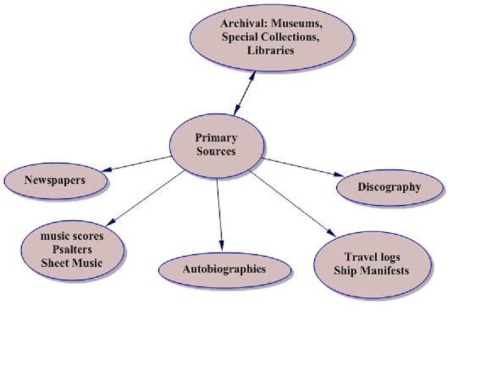 If helpful: Duplicate and use. Please give credit:
If helpful: Duplicate and use. Please give credit:
Delores Fisher, “Archival Research Design 1 A Few Thoughts On How to Get Started-Conducting Music History Archival Research,” San Diego Archives 1800s-Early 1900s, Entry Posted March 23, 2012, https://sonictapestry.wordpress.com.
Additional Ways to Conduct Archival Reasearch
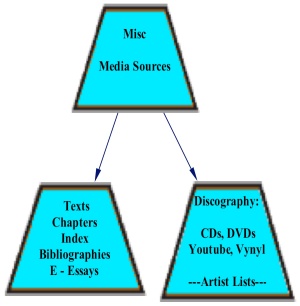
If helpful: Duplicate and use. Please give credit:
Delores Fisher, “Archival Research Design 1 A Few Thoughts On How to Get Started-Conducting Music History Archival Research,” San Diego Archives 1800s-Early 1900s, Entry Posted Dec. 20, 2012, https://sonictapestry.wordpress.com.
Perhaps you want to enjoy hearing some of the music you are writing about. Various modern interpretations often do not exist. Then, you must try to find primary aural/visual sources. Several film documentaries also have retained or restored original music files with their reproductions. If you decide to listen to archive recordings whether old piano rolls, vinyl, shellac, documentaries with soundbites, or reclaimed CDs from carbon cylinders, try these tips reformulated from my African American Music History listening exercises:
Document/Describe What You Hear
Time Period:
Media Format:
Genre/Style:
Performers (Briefly describe):
Lyrics Circle What Applies: Religious? Non-Religious? Love Ballad? Lament? Work Song? Cautionary Tale? Satire? Dance/Party Lyrics? Social Commentary?
Comments Describe–Prose, Rhyme, voice/chorus, repeated phrase(s), boasting, nonsense words, inspirational, etc.:
Voice Quality: Natural(Raw-gravelly, nasal)? Trained(operatic, theater/big voice) ?
Describe Any NOTABLE Uniqueness (compared to previous listening–like Mariah Carey: Whistle Tones, Whitney Houston: Melismas)
Instruments—List:
SOCIO-CULTURAL ASPECTS :
Surrounding Historical-(Social conflict? Generational tension?, Gender dominated? (more men musicians, more women ?Created for specific purpose?, Resulted in censorship?, etc.)
(If helpful: Duplicate and use. Please give credit:
Delores Fisher, “Archival Research : A Few Thoughts On How to Get Started-Conducting Music History Archival Research,” San Diego Archives 1800s-Early 1900s, Entry Posted March 23, 2012, https://sonictapestry.wordpress.com. Dec. 20)
__________________________________________________________________________________________________________________________________________________________________________________________________________________________________________________________________________________________________________________________________________
SAN DIEGO MUSIC BEFORE 1900
Although my recent research into general African American pop music started in the 1990s, it was not a focal topic that held my interest. Prior research consisted of collecting historical information and participating in performances of spirituals and folk songs. In the 1970s, I had attended lectures on Black sacred music during the National Baptist Conventions in New York State as a youth delegate for my home church. Several years after I moved to San Diego, I began lecturing about African American sacred music at churches during Black history month. Through the years, however, I’ve been drawn to archival research. I became fascinated with early “legitimate” Black musical theater and its relationship to minstrelsy from the early 1800s up through 1950.
I soon realized that although not much was written about African Americans in San Diego music history before 1900 through the lens of archival newspaper inquiry 1. I have been teaching African American Music History for the Department of Africana Studies at San Diego State University since 2008. When I became part time junior faculty, my colleagues constantly encouraged me to continue my work. Without their support, this section of Sonictapestry would more than likely not have been written.
Wondering which newspapers to search for and what starting date and year to choose, I reread several chapters from pioneering African American Music History documentation by James Trotter 2. He provides bibliographic as well as newspaper archive portraits of major pre-twentieth century African American musicians. I then settled on a very popular local newspaper, the San Diego Tribune with January 1900 as a starting date. That year presented more information than I anticipated, so I pushed my date back to include January 1890. Newspaper archives have been extensively digitalized, but I enjoy the hours of searching thorough on-site manual machines. Many of the microfiche reproductions are difficult to read. Cross referencing with other pre-1900 San Diego newspapers take hours of work.
Articles so far have yielded a portrait of San Diego as a city where classically trained musicians frequently concertized in churches, social halls and various opera houses. San Diego California with its home grown minstrel musicians, was also a favorite stop for national shows on the Minstrel circuit. Fisher Opera House, the Louis Opera House and other theaters provided a stage for African American traveling troupes. Below is a sample of San Diego historic newspaper articles that feature classical and popular performers.
ENDNOTES
1.Groundbreaking scholarly work has been done on San Diego history by mentors Gloria Rhodes, SDSU Librarian and Diversity Bibliographer Bibliographer http://newscenter.sdsu.edu/lead/facstaffresources.aspx and historian Robert Fikes Jr. http://newscenter.sdsu.edu/sdsu_newscenter/news.aspx?s=72393 They provide a gracious ear and sound cautionary methodology suggestions. They are always ready to listen to recent challenges.
One of Fikes early contributions to the literature include collaboration on an article for the San Diego Historical Society: Gail Madyun and Larry Malone, “Black Pioneers in San Diego: 1880-1920 with an essay by Robert Fikes Junior, The Journal Of San Diego History, Volume XXVII Spring 1981, #2,(San Diego Historical Society: San Diego CA., 1981.)91-114. Also San Diego African American music history inquiry by Dr. Eddie Meadows, Jacqueline Djedje Cogdell and Eddie Meadows, California Soul: Music of African Americans in the West, (Berkeley: University of California Press, 1998).
2. James trotter, Music and Some Highly Musical People: Remarkable Musicians of the Colored Race (New York: Johnson Reprint Corporation, 1968)
MUSEWOMAN/ DELORES FISHER
THOMAS GREEN WIGGINS BETHUNE: PIANIST EXTRAORDINAIRE
(Also known as “Blind” Tom Bethune)
San Diego Daily Bee 1887 Blind Tom
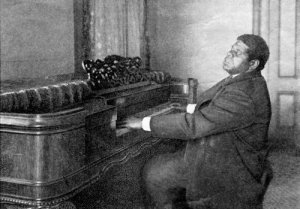
“Blind Tom” at the piano
While randomly searching for music and musician related headlines in three focus papers from the late 1800s San Diego newspaper microfiche archives on an inner “hunch” last summer, I found an interesting item.1 It was a short paragraph on the 19th century musical genius: African American pianist “Blind Tom” Bethune (1849-1909). I remembered a section dedicated to Bethune in Eileen Southern’s seminal text. 2 Although research so far has not revealed that Tom concertized in San Diego, it is interesting to note the extent of his fame.
Although listed in most African American music history texts since Southern, the life story of Blind Tom Bethune and his amazing abilities of , is getting a lot of Internet “buzz” in the 21st century. I recommend this source: http://www.blindtom.org/
Tom was identified in early childhood as a somewhat eccentric behaviors including a strong visceral responses to sounds, especially music; after his master’s family determined that he was truly gifted, they cultivated Tom’s musical gifts in what would today be considered a non-traditional approach.3 As a young man, he concertized and became an admired pianist. James Trotter’s book on African American musicians during the late 1800s suggests that he was also what we now call a “savant.”
In the mid to late twentieth music community, American popular music produced several blind musicians of note. Ray Charles, Jose Felciano, Ronnie Milsap to list only a few. I was well acquainted with their work as a teen. Before the Internet and social media, their vinyl records and sheet various instrumental music renditions could be purchased in music stores all across the U.S. Progressive programming Radio stations played Ray Charles, Ronnie Milsap, and Jose Feliciano.4 However, I had been unaware of nineteenth century visually impaired musicians who achieved not only national recognition, but also international status.
While compiling research and reviewing Black music history textbooks, I first encountered Blind Tom’s biography in Eileen Southern’s History of African Amercian Music 2nd edition while preparing to teach Afras 385 (African American Music) for the Africana Studies Department at San Diego State University in the mid 2000s. Despite Southern’s inclusion of Bethune, very little had been written on him at that time in contemporary music history texts. Tom’s short bio is informative on socio-cultural interactions between talented slaves and their masters. Yet, for me, Bethune’s bio raised more questions. 5 One of which was, but why was he so famous?
Several answers emerged with further research. Tests were conducted to confirm his abilities. He toured beyond the United States. His program notes were preserved. Some of his piano compositions were transcribed and published. Southern’s treatment of Bethune also notes that he opened the door for other African American blind musical prodigies to concertize.6 His inspiring life was filled with controversy as a slave who could not represent himself. Her documentation on Bethune pointed to additional information sources that were difficult to trace at that time. Apparently, some were and still are either out of print or difficult to obtain. 7
While preparing to teach an African American Music History course back in 2007, I was also reading James M. Trotter’s Music and Some Highly Musical People, Music and Some Highly Musical People mentioned by Southern as an 1800s source text.8 Trotter devotes and entire chapter to Bethune. This musical profile quotes from a biography of the era and provides background information about Tom’s childhood; these early biographical details provide a key to Tom Bethune’s unusual adult mannerisms.It describes Tom’s childhood, his introduction to the piano, his obsessive fascination with its sounds.9 Trotter tries to reveal as much as he can without fueling the controversy surrounding Tom’s genius.
His appraisal of Bethune’s musicianship is almost overstated, as if to dispel documentation of his unusual behaviors “He is unquestionably and conspicuously the most wonderful musician the world has ever known. . . . He is an absolute master in the comprehension and retention of all sound(and in all sound he finds music).” 10
Trotter includes national and international newspaper article excerpts about Tom’s amazing musical abilities from sources as divers as “The Albany (N.Y.) Argus,” “The Manchester (Eng) Courier,” and “The Glosgow (Scotland) Daily Herald.” 11 The excerpt below is one of my archival newspaper research finds. It opens a window onto Tom’s family’s interactions with exploitative remnants of physical and economic slavery.
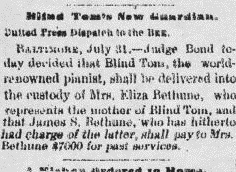
The entry above notes:
Judge Bond today decided that Blind Tom, world renowned pianist, shall be delivered into the custody of Mrs. Elilza Bethune, who represents the mother of Blind Tom, and that James S. Bethune, who has hitherto had charge of the latter, shall pay to Mrs. Bethune 7,0000 for past services.12
One would consider that such a sum was quite considerable for a slave’s wages and that James S. Bethune was probably not pleased about the judges ruling in the Bethune family’s favor. Finding this United Press Dispatch to the San Diego Daily Bee from Baltimore was surprise. It is a rare jewel. The short entry is in the Sunday July 31st 1887 edition of the San Diego Daily Bee newspaper (Vol.1, No. 123) and is arguably further proof of Blind Tom Greene’s ever tenuous status as a person and as a musician of note on a national level beyond his status as a slave.
Endnotes
1. From time to time these hunches have lead me to texts on shelves, articles in JSTOR, hard to find records in bins of unique record shops, and special edition CDs in “going out of business” sales in once huge music selling venues that have shut their doors in America’s changing commercial big chain shopping malls. That summer, I had been concentrating on newspaper archives at San Diego State University and the San Diego Main Public Library. I found several small newspapers of interest including the San Diego Sun And the Herald. That week, I concentrated on the San Diego Daily Bee which had not merged with the San Diego Union Tribune at that time (1855).
2. Eileen Southern. “After The War.” The Music of Black Americans: A History 2nd ed.(New York: W.W.Norton & Company 1983) 246-247. Third edition pages: 249-251.
3. James Trotter. “Thomas Greene Bethune, Otherwise Known as “Blind Tom,” The Wonderful Pianist”. in Music and Some Highly Musical People, Music and Some Highly Musical People ( New York: Johnson Reprint Corporation, 1968) 141-168. Originally printed in Boston:1881.
4. Because I channel surfed as a child, I know that Milsap was played quite frequently by Country and Western stations; Ray Charles was played was really big on Black stations. Feliciano may have played Spanish speaking stations at that time, but I wasn’t aware of it where I lived. But I do know that Feliciano and Charles also played pop stations when their styles became more”pop/cross-over.”
5. Eileen Southern. “After The War.” The Music of Black Americans: A History 2nd ed.(New York: W.W.Norton & Company 1983) 246-247.
6.Ibid., 246-247, Eileen Southern, “After The War.” The Music of Black Americans: A History 3rd ed.(New York: W.W.Norton & Company 1997) 250.
7. Her bio about Bethune lists the work of seminal work of African American musician/ educator Dr. Geneva Southall, Blind Tom: The Post-Civil War Enslavement of a Black Musical Genius,(Minneapolis, 1979). Southall later wrote a book about Thomas Green Bethune: Blind Tom, the Black Pianist-Composer (1849-1908): Continually Enslaved (Oxford: Scarecrow Press, Inc, 1999). For a limited view of this text click onto the link: http://books.google.com/books?id=k1AOKfQTM1QC&lpg=PP1&pg=PR2#v=onepage&q&f=false
8. Eileen Southern. “After The War.” The Music of Black Americans: A History 2nd ed.(New York: W.W.Norton & Company 1983). According to Southern: “It remained for a nonprofessional to produce the historical landmark of the period: in 1878 James Monroe Trotter (1842-92) published a general survey of black American music titled Music and Some Highly Musical People, Music and Some Highly Musical People. This was the first time in the history of the nation that anyone, black or white, had attempted to assess a body of American music the cut across genres and styles.” 259. The text’s third edition omits this paragraph.
9. James Trotter. “Thomas Greene Bethune, Otherwise Known as “Blind Tom,” The Wonderful Pianist”. in Music and Some Highly Musical People, Music and Some Highly Musical People ( New York: Johnson Reprint Corporation, 1968) 141-168. Originally printed in Boston:1881.
10. Ibid.,145-148.
11. Ibid. 141,
12. Ibid., 149-156.
Minstrelsy San Diego 1880-1895
Many African American troupes visited the city. The Fisher Opera House and other theaters were part of an entertainment network circuit for other performers as well, including Paul Boulon’s “celebrated California Ladies Brass Band and Orchestra and Comedy Company” (see San Diego Union and Bee Nov.14,1887), the concert pianist Paderewski (see the San Diego Union Friday March 23, 1900, pg 4).
Minstrelsy troupes, Black (African American) as well as White, traveling circuses, traveling “Uncle Tom’s Cabin shows all came through San Diego before and after the turn of the 20th century. Twenty-first century views of minstrelsy based on visual distortions of African Americans’ physical features, attire, dialect, and dance styles provide a corrective to what once was construed as harmless fun that resulted in stereotypes that haunt our twenty first century racial and ethnic media images like ghostly negatives. Minstrelsy provided live entertainment based on racially charged parody, distance from racial hostility through comic exaggeration.
Thomas Riis notes:
Because popular theatricals throughout history have delineated, lampooned, and translated contemporary life, African Americans were portrayed for the American public well before they had full control of the messages given out by actors or directors in formal works for the stage. (On the other hand, many White minstrels often claimed to depict accurately the lives of Blacks whom they observed around them.) 187.
Many white performers were praised for their portrayals and gained national popularity. San Diego newspapers reveal that San Diego was on the performance circuit for local and national touring companies.
The Barlow brothers Billy and James were White minstrels renowned for their blackface routines. Billy Barlow and James Barlow toured with their famous ensemble the Mammoth Minstrels. Several versions of Mammoth Minstrels owned by various backers toured the US; depending on the source, several performers took the name of Billy Barlow. Ironically, one Billy Barlow was shot and killed during a burglary after he had apparently retired from active stage performance. http://www.barlowgenealogy.com/Arkansas/Cemetery/Obituaries/obituaries.html
This small add in the San Diego Union, pg.5 Monday January 1st 1894 promises “a night of melody and mirth.” The traditional minstrel troupe Grand street parade, which usually included music provided by the company’s stage band, also served as a showcase other performers (jugglers, arcobats, etc). Watching parades and listening to marching bands was an American past time during that era. The Barlow Bros. Mammoth Minstrels more than likely were not integrated since most bands during that era were segregated.
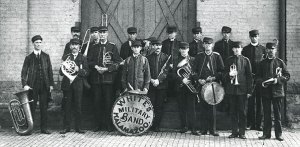
Military Band
The Mammoth Minstrels parade is announced as starting at 2:00PM, a good time of the day to gather a crowd and generate excitement for their show. The Fisher Opera house, as well as a few others (more on the theaters of San Diego at a later date) play a major role in attracting minstrel troupes to San Diego.
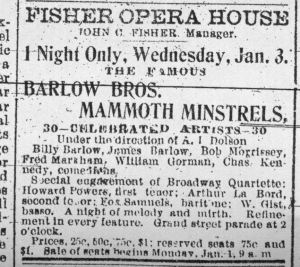
Barlow brothers Mammoth Minstrels
As traveling shows performed from town to town, they inspired many young musicians with a goal, to gain experience by playing for one of the shows, even if only as a substitute or itinerant hire for a few shows. The more experience, the better the chance of becoming a permanent hire. Marching and show bands and parades were enjoyed across a broad spectrum of American audiences. African American marching bands were no novelty, many times started in churches or orphanages as a way to provide black youth with a basic music educations, entertainment, and a usable skill. see http://archsocialclub.com/ascupdate/and-the-bands-play-on/
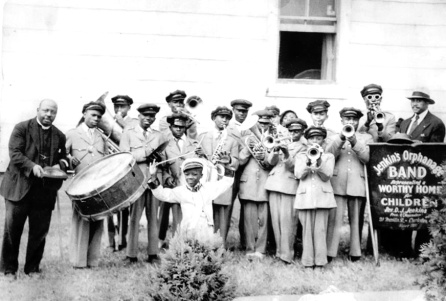
Jenkins Orphanage Band
Although singers and dancers were in demand, experienced instrumentalists, jazz, classical, self taught or educated could find employment Minstrel Bands were quite common. Often, the segregated bands would accompany various skits and song during tent and theater performances as well as provide pre- show music with promotional parades in flamboyant costumes musical arrangements in each town the company visited. Race specific segregated touring companies traveled across the North, Mid-west, South, and the West coast. Many larger minstrel companies toured Europe
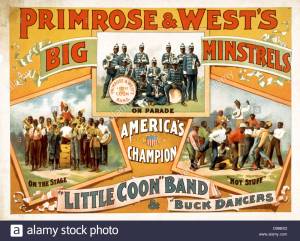
Minstrel Band Poster
Owned by Whites, the large company of Richards and Pringle’s Georgia Minstrels is a well known minstrelsy troupe in African American Music History.2 It is only one of several touring troupes during that era called Georgia Minstrels;according to Eileen Southern, “In April of that year [1865], white entrepreneur W.H. Lee organized a troupe of fifteen ex-slaves in Macon Georgia, and called them the Georgia Minstrels.”3 Adding to the newspaper documentation about Richard’s and Pringle’s Minstrels is this promotional add that I found in an issue of the 1894 San Diego Union. The promotional add announces the touring company’s show on Sunday March 18th, 1894. Two very well known and popular Black performers were part of the troupe, minstrel man Billy Kersands 4 and vocalist Black Patti 5 (originally an opera singer and later head of her own traveling show).
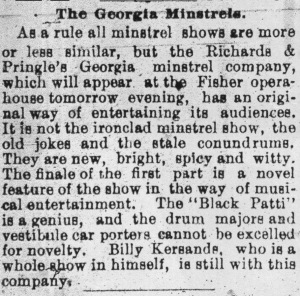
Richards and Pringle’s Georgia Minstrels
END NOTES
1 Thomas L. Riis, “Musical Theater: A Chronological Survey” African American Music: An Introduction. Mellonee V. Burnim and Portia K. Maultsby eds., (New York: Routledge, 2006), 187.
2. Eileen Southern. “After the War.” The Music of Black Americans: A History. (New York: W.W. Norton & Company: 1983), 230.
3. Ibid., 229.
4. Lynn Abbott and Doug Seroff. “Richards and Pringle’s Original Georgia Minstrels and Billy Kersands, 1889-1895.” Out of Sight: The Rise of African American Popular Music, 1889-1895. (University Press of Mississippi: 2002). 106-110. Abott and Seroff provide insight into Kersands artistry as weel as his effect on young performers.
SAN DIEGO CHURCH CONCERTS
Area churches also provided performance space for classical musicians. The First Presbyterian Church hosted a concert for the Fisk Jubilee Singers on tour during 1890. http://www.fiskjubileesingers.org/our_history.html They were billed as the original company (a few copy groups were touring at the time). Sponsored by the Young Men’s Christian Association, tickets for this concert sold for fifty cents. The performance announced in this San Diego Union promo add is dated Wednesday morning, January 15th 1890. The Fisk Jubilee singers were scheduled to do two concerts, one on Monday evening January 27th, the other on Tuesday evening, January 28th.
San Diego Union Tribune 1890 Fisk Jubilee Singers Visit San Diego
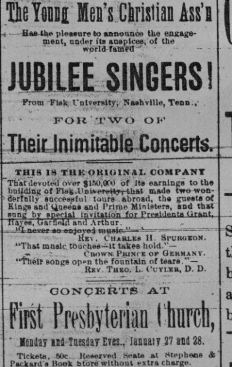
Fisk Jubilee Singers
Historic Recording
Fisk Jubilee Singers Today
Their origins were humble, but as their musicianship increased, so did their respect for their artistry. The historic Fisk Jubilee singers had many imitators. This snippet suggests that this was the real ensemble. World travelers whose music inspired their era, the music of today’s Fisk Jubilee singers continue to provide entertainment and inspiration for the world.
MUSEWOMAN/ DELORES FISHER


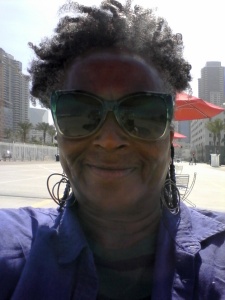
I know the Spreckels Organ Society has historical records going back about a hundred years, from the establishment of the Organ Pavillion in Balboa Park. They’d probably be a good resource for you!
LikeLike
Yes indeed, the Spreckels Organ Society are a good source of archival information. If you attend their weekly concerts in Balboa Park (I’ve written music reviews on our world famous civic organist Dr. Carol Williams) the society is usually on site and very willing to engage a researcher in conversation.
LikeLike
I have been exploring for a little bit for any high quality articles or blog posts in this kind of house . Exploring in Yahoo I ultimately stumbled upon this web site. Studying this info So i am happy to express that I’ve an incredibly excellent uncanny feeling I came upon just what I needed. I such a lot certainly will make certain to don¡¦t disregard this web site and provides it a look on a continuing basis.
LikeLike
Howdy! Do you know if they make any plugins to safeguard against hackers? I’m kinda paranoid about losing everything I’ve worked hard on. Any tips?|
LikeLike
May I simply just say what a comfort to uncover somebody who actually knows what they’re talking about on the web. You definitely understand how to bring a problem to light and make it important. More people need to look at this and understand this side of the story. I was surprised you’re not more popular because you surely have the gift.
LikeLike
Right here is the right blog for everyone who wants to understand this topic. You realize a whole lot its almost tough to argue with you (not that I actually would want to…HaHa). You definitely put a fresh spin on a topic which has been discussed for decades. Wonderful stuff, just excellent!
LikeLike
I just want to tell you that I’m beginner to blogging and definitely loved your blog site. More than likely I’m likely to bookmark your site . You actually come with beneficial article content. With thanks for sharing your web-site.
LikeLike
Saved as a favorite, I love your web site!
LikeLike
I just want to mention I am just new to blogs and actually enjoyed this web blog. Most likely I’m likely to bookmark your site . You actually come with very good writings. Thanks for sharing with us your web-site.
LikeLike
Hey there! Where did you get theme of this blog? It’s incredible 😉
LikeLike
The theme evolved as I began to search various websites for information about local and national African American music articles.
Delores Fisher
Musewoman
LikeLike
It’s really a good and helpful piece of information. I am happy that you simply shared this useful information with us. Please keep us up to date similar to this. Thank you for sharing.
LikeLike
I just want to say I am just newbie to blogging and definitely loved this web-site. Probably I’m planning to bookmark your website . You absolutely have really good well written articles. Regards for sharing with us your blog.
LikeLike
Thank you.
It’s an interesting feeling to share with so many people world wide.
As the research continues, I notice so many topics I’d like to discuss,
but I’m thankful for our diverse blogger world; we can all contribute to
the current information that’s out there.
Musewoman,
Delores Fisher
LikeLike
This blog was… how do I say it? Relevant!! Finally I have found something which helped
me. Appreciate it!
LikeLike
Enjoy your blog )
http://t4sbami1.com my blog
LikeLike
Thank you,
It is a process . . .Readers’ support is important
validation.
LikeLike
Great amazing things here. I am very happy to see your post. Thanks a lot and i’m taking a look ahead to contact you. Will you kindly drop me a mail?
LikeLike